Viscosity Loss and Hydraulic Pressure Drop on Multilayer Separate Polymer Injection in Concentric Dual-Tubing
Abstract
:1. Introduction
2. Downhole Polymer Injection Process
2.1. Model Description
2.2. Solution of General Heat Transfer Equation
2.3. Heat Transfer in and out of the Wellbore
2.4. Temperature Calculation at the Cement–Formation Interface and Inner Surface of the Casing
2.5. Energy Balance Equation
2.6. Temperature–Viscosity Relationship for the Polymer
3. Solution Methods
4. Results and Discussions
4.1. Parameter Combination
4.2. Temperature Distribution in the Wellbore
4.3. Average Viscosity Distribution in the Wellbore
4.4. Hydraulic Pressure Drop in the Wellbore
4.5. Flowing Behavior and Hydraulic Friction in the Wellbore
5. Conclusions
Author Contributions
Funding
Conflicts of Interest
References
- Garmeh, G.; Izadi, M.; Salehi, M.; Romero, J.L.; Thomas, C.; Manrique, E.J. Thermally active polymer to improve sweep efficiency of waterfloods: Simulation and pilot design approaches. SPE-144234-PA 2012, 15, 86–97. [Google Scholar] [CrossRef]
- Al-Shakry, B.; Skauge, T.; Shaker Shiran, B.; Skauge, A. Polymer injectivity: Investigation of mechanical degradation of enhanced oil recovery polymers using in-situ rheology. Energies 2019, 12, 49. [Google Scholar] [CrossRef] [Green Version]
- Sheng, J.J.; Leonhardt, B.; Azri, N. Status of polymer-flooding technology. J. Can. Pet. Technol. 2015, 54, 116–126. [Google Scholar] [CrossRef]
- Wang, D.; Dong, H.; Lv, C.; Fu, X.; Nie, J. Review of practical experience by polymer flooding at Daqing. SPE Reserv. Eval. Eng. 2009, 12, 470–476. [Google Scholar] [CrossRef]
- Gao, C. Viscosity of partially hydrolyzed polyacrylamide under shearing and heat. J. Pet. Explor. Prod. Technol. 2013, 3, 203–206. [Google Scholar] [CrossRef] [Green Version]
- Godwin Uranta, K.; Rezaei-Gomari, S.; Russell, P.; Hamad, F. Studying the effectiveness of polyacrylamide (pam) application in hydrocarbon reservoirs at different operational conditions. Energies 2018, 11, 2201. [Google Scholar] [CrossRef] [Green Version]
- Li, X.E.; Xu, Z.; Yin, H.; Feng, Y.; Quan, H. Comparative studies on enhanced oil recovery: Thermoviscosifying polymer versus polyacrylamide. Energy Fuels 2017, 31, 2479–2487. [Google Scholar] [CrossRef]
- Sheng, J.J. Critical review of alkaline-polymer flooding. J. Pet. Explor. Prod. Technol. 2017, 7, 147–153. [Google Scholar] [CrossRef]
- Olajire, A.A. Review of ASP EOR (alkaline surfactant polymer enhanced oil recovery) technology in the petroleum industry: Prospects and challenges. Energy 2014, 77, 963–982. [Google Scholar] [CrossRef]
- Liao, G.; Wang, Q.; Wang, H.; Liu, W.; Wang, Z. Chemical flooding development status and prospect. Acta Pet. Sin. 2017, 38, 196–207. [Google Scholar]
- Liang, S.; Liu, Y.; Hu, S.; Shen, A.; Yu, Q.; Yan, H.; Bai, M. Experimental study on the physical performance and flow behavior of decorated polyacrylamide for Enhanced Oil Recovery. Energies 2019, 12, 562. [Google Scholar] [CrossRef] [Green Version]
- Sun, C.; Hou, J.; Pan, G.; Xia, Z. Optimized polymer enhanced foam flooding for ordinary heavy oil reservoir after cross-linked polymer flooding. J. Pet. Explor. Prod. Technol. 2016, 6, 777–785. [Google Scholar] [CrossRef] [PubMed]
- Saboorian-Jooybari, H.; Dejam, M.; Chen, Z. Half-century of heavy oil polymer flooding from laboratory core floods to pilot tests and field applications. In Proceedings of the SPE Canada heavy oil technical conference, Calgary, AB, Canada, 9–11 June 2015. [Google Scholar]
- Saboorian-Jooybari, H.; Dejam, M.; Chen, Z. Heavy oil polymer flooding from laboratory core floods to pilot tests and field applications: Half-century studies. J. Pet. Sci. Eng. 2016, 142, 85–100. [Google Scholar] [CrossRef]
- Delamaide, E. Polymer flooding of heavy oil-from screening to full-field extension. In Proceedings of the SPE Heavy and Extra Heavy Oil Conference: Latin America, Medellin, Colombia, 24–26 September 2014. [Google Scholar]
- Kuiqian, M.; Yanlai, L.; Lilei, W.; Xiaolin, Z. Practice of the early stage polymer flooding on LD offshore oilfield in Bohai bay of China. In Proceedings of the SPE Asia Pacific Enhanced Oil Recovery Conference, Kula Lumpur, Malaysia, 11–13 August 2015. [Google Scholar]
- Sun, L.; Li, B.; Jiang, H.; Li, Y.; Jiao, Y. An injectivity evaluation model of polymer flooding in offshore multilayer reservoir. Energies 2019, 12, 1444. [Google Scholar] [CrossRef] [Green Version]
- Tie, L.; Yu, M.; Li, X.; Liu, W.; Zhang, B.; Chang, Z.; Zheng, Y. Research on polymer solution rheology in polymer flooding for Qikou reservoirs in a Bohai Bay oilfield. J. Pet. Explor. Prod. Technol. 2019, 9, 703–715. [Google Scholar] [CrossRef] [Green Version]
- Zheng, W.; Jiang, H.; Zhang, X.; Li, J.; Chen, M.; Ma, J. Offshore polymer flooding optimization using surrogate-based methodology. Pet. Sci. Technol. 2011, 29, 1227–1235. [Google Scholar] [CrossRef]
- He, H.; Chen, Y.; Yu, Q.; Wen, X.; Liu, H. Optimization design of injection strategy for surfactant-polymer flooding process in heterogeneous reservoir under low oil prices. Energies 2019, 12, 3789. [Google Scholar] [CrossRef] [Green Version]
- Liu, S.; Shen, A.; Qiu, F.; Liang, S.; Wang, F. Matching relationship and alternating injection for polymer flooding in heterogeneous formations: A laboratory case study of daqing oilfield. Energies 2017, 10, 1018. [Google Scholar] [CrossRef] [Green Version]
- Sidiq, H.; Abdulsalam, V.; Nabaz, Z. Reservoir simulation study of enhanced oil recovery by sequential polymer flooding method. Adv. Geo-Energy Res. 2019, 3, 115–121. [Google Scholar] [CrossRef]
- Wang, X.; Zhang, J.; Kang, X.; Wei, Z.; Meng, F.; Zhu, Y. Injection capacity analysis of downhole polymer injection pipe string in Bohai oilfield based on power law fluid model. China Offshore Oil Gas 2017, 29, 87–92. [Google Scholar]
- Jennings, R.R.; Rogers, J.H.; West, T.J. Factors influencing mobility control by polymer solutions. SPE-2867-PA 1971, 23, 391–401. [Google Scholar] [CrossRef]
- Weiss, W.W.; Baldwin, R.W. Planning and implementing a large-scale polymer flood. SPE-2867-PA 1985, 37, 720–730. [Google Scholar] [CrossRef]
- Green, D.W.; Willhite, G.P. Enhanced Oil Recovery; Henry, L., Ed.; Doherty Memorial Fund of AIME, Society of Petroleum Engineers: Richardson, TX, USA, 1998; Volume 6. [Google Scholar]
- Zhang, L.-J.; Yue, X.-A. Displacement of polymer solution on residual oil trapped in dead ends. J. Cent. South Univ. Technol. 2008, 15, 84–87. [Google Scholar] [CrossRef]
- Zhang, Z.; Li, J.; Zhou, J. Microscopic roles of “viscoelasticity” in HPMA polymer flooding for EOR. Transp. Porous Media 2011, 86, 199–214. [Google Scholar] [CrossRef] [Green Version]
- Restolho, J.; Serro, A.P.; Mata, J.L.; Saramago, B. Viscosity and surface tension of 1-ethanol-3-methylimidazolium tetrafluoroborate and 1-methyl-3-octylimidazolium tetrafluoroborate over a wide temperature range. J. Chem. Eng. Data 2009, 54, 950–955. [Google Scholar] [CrossRef]
- Zheng, M.; Tian, J.; Mulero, Á. New correlations between viscosity and surface tension for saturated normal fluids. Fluid Phase Equilibria 2013, 360, 298–304. [Google Scholar] [CrossRef] [Green Version]
- Haj-Kacem, R.B.; Ouerfelli, N.; Herráez, J.; Guettari, M.; Hamda, H.; Dallel, M. Contribution to modeling the viscosity Arrhenius-type equation for some solvents by statistical correlations analysis. Fluid Phase Equilibria 2014, 383, 11–20. [Google Scholar] [CrossRef]
- Nian, Y.-L.; Cheng, W.-L. Evaluation of geothermal heating from abandoned oil wells. Energy 2018, 142, 592–607. [Google Scholar] [CrossRef]
- Cheng, W.-L.; Huang, Y.-H.; Lu, D.-T.; Yin, H.-R. A novel analytical transient heat-conduction time function for heat transfer in steam injection wells considering the wellbore heat capacity. Energy 2011, 36, 4080–4088. [Google Scholar] [CrossRef]
- Livescu, S.; Wang, X. Analytical downhole temperature model for coiled tubing operations. In Proceedings of the SPE/ICoTA Coiled Tubing and Well Intervention Conference and Exhibition, Woodlands, TX, USA, 25–26 March 2014. [Google Scholar]
- Luo, L.; Tian, F.; Cai, J.; Hu, X. The convective heat transfer of branched structure. Int. J. Heat Mass Transf. 2018, 116, 813–816. [Google Scholar] [CrossRef]
- Wooley, G.R. Computing downhole temperatures in circulation, injection, and production wells. SPE-2867-PA 1980, 32, 1,509–501,522. [Google Scholar] [CrossRef]
- Smith, R.; Steffensen, R. Interpretation of temperature profiles in water-injection wells. SPE-2867-PA 1975, 27, 777–784. [Google Scholar] [CrossRef]
- Okoya, S.S. Computational study of thermal influence in axial annular flow of a reactive third grade fluid with non-linear viscosity. Alex. Eng. J. 2019, 58, 401–411. [Google Scholar] [CrossRef]
- Yi, L.-P.; Li, X.-G.; Yang, Z.-Z.; Sun, J. Coupled calculation model for transient temperature and pressure of carbon dioxide injection well. Int. J. Heat Mass Transf. 2018, 121, 680–690. [Google Scholar] [CrossRef]
- Sun, F.; Yao, Y.; Li, X.; Yu, P.; Zhao, L.; Zhang, Y. A numerical approach for obtaining type curves of superheated multi-component thermal fluid flow in concentric dual-tubing wells. Int. J. Heat Mass Transf. 2017, 111, 41–53. [Google Scholar] [CrossRef]
- Batra, R.L.; Sudarsan, V.R. Laminar flow heat transfer in the entrance region of concentric annuli for power law fluids. Comput. Methods Appl. Mech. Eng. 1992, 95, 1–16. [Google Scholar] [CrossRef]
- Pinho, F.T.; Coelho, P.M. Fully-developed heat transfer in annuli for viscoelastic fluids with viscous dissipation. J. Non-Newton. Fluid Mech. 2006, 138, 7–21. [Google Scholar] [CrossRef]
- Allanic, N.; Deterre, R.; Mousseau, P.; Couedel, D. Thermal Behavior of a Concentric Annular Polymer Flow. In AIP Conference Proceedings; AIP Publishing LLC: Kerala, India, 2019. [Google Scholar]
- Li, Z.; Delshad, M. Development of an analytical injectivity model for non-newtonian polymer solutions. SPE J. 2014, 19, 381–389. [Google Scholar] [CrossRef]
- Hasan, A.; Kabir, C. Heat transfer during two-phase flow in wellbores; Part I—formation temperature. In Proceedings of the SPE Annual Technical Conference and Exhibition, Dallas, TX, USA, 6–9 October 1991. [Google Scholar]
- Holman, J.P. Heat Transfer, 10th ed.; McGraw-Hill: Dubuque, IA, USA, 2009. [Google Scholar]
- Akter, S.; Hashmi, M.S.J. Analysis of polymer flow in a conical coating unit: A power law approach. Prog. Org. Coat. 1999, 37, 15–22. [Google Scholar] [CrossRef]
- Monroy, F.; Hilles, H.M.; Ortega, F.; Rubio, R.G. Relaxation dynamics of langmuir polymer films: A power-law analysis. Phys. Rev. Lett. 2003, 91, 268302. [Google Scholar] [CrossRef]
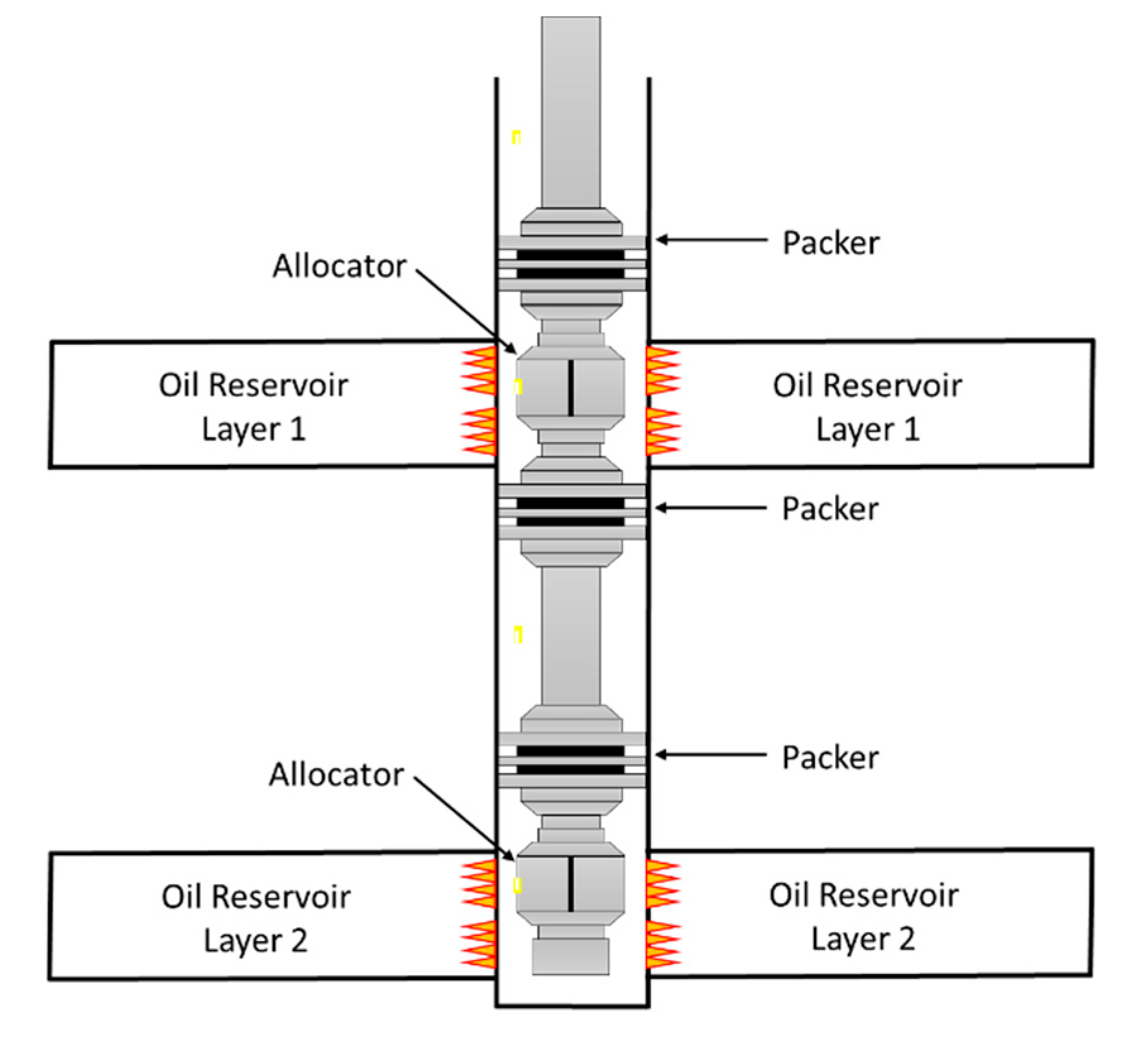

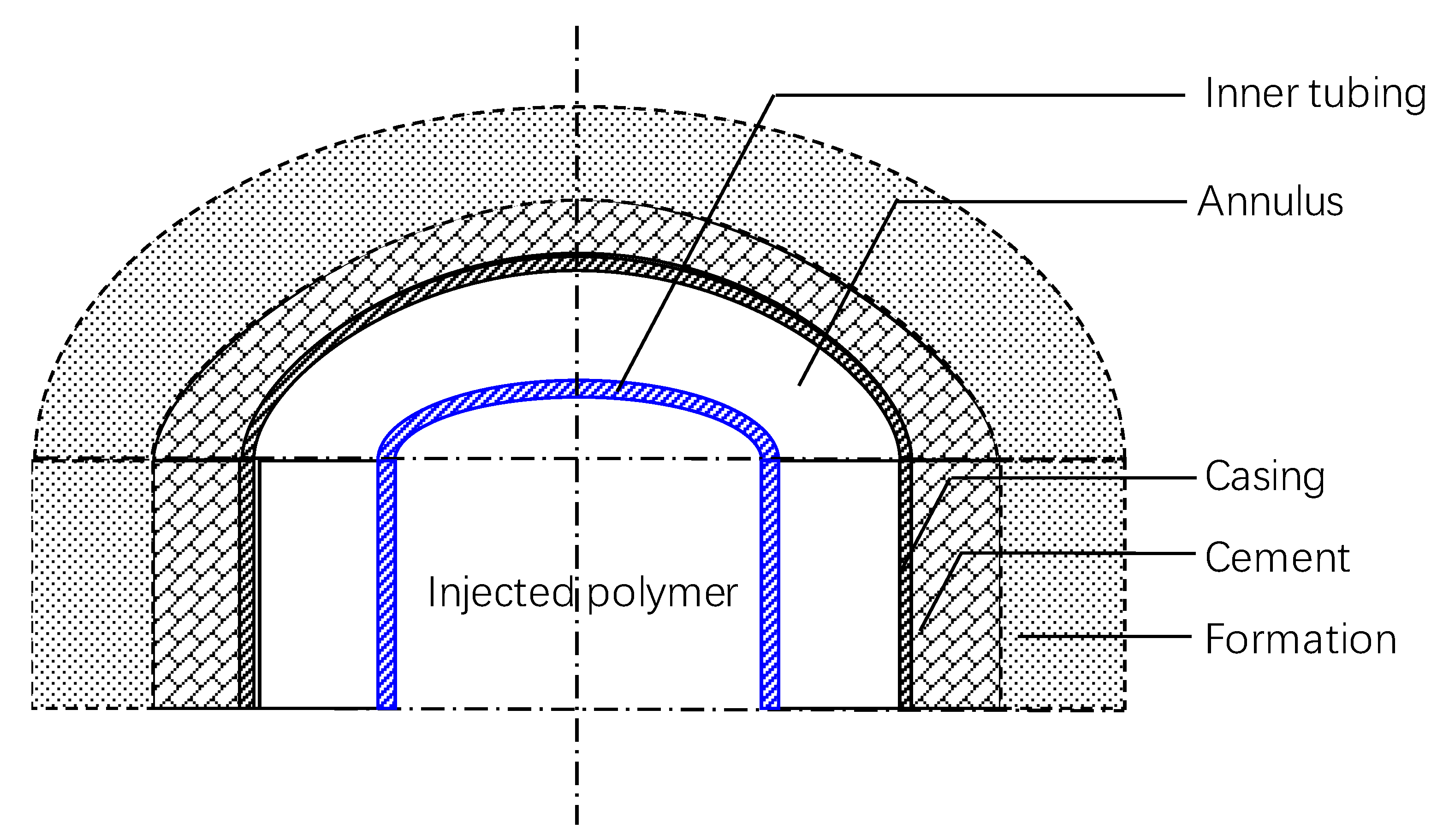



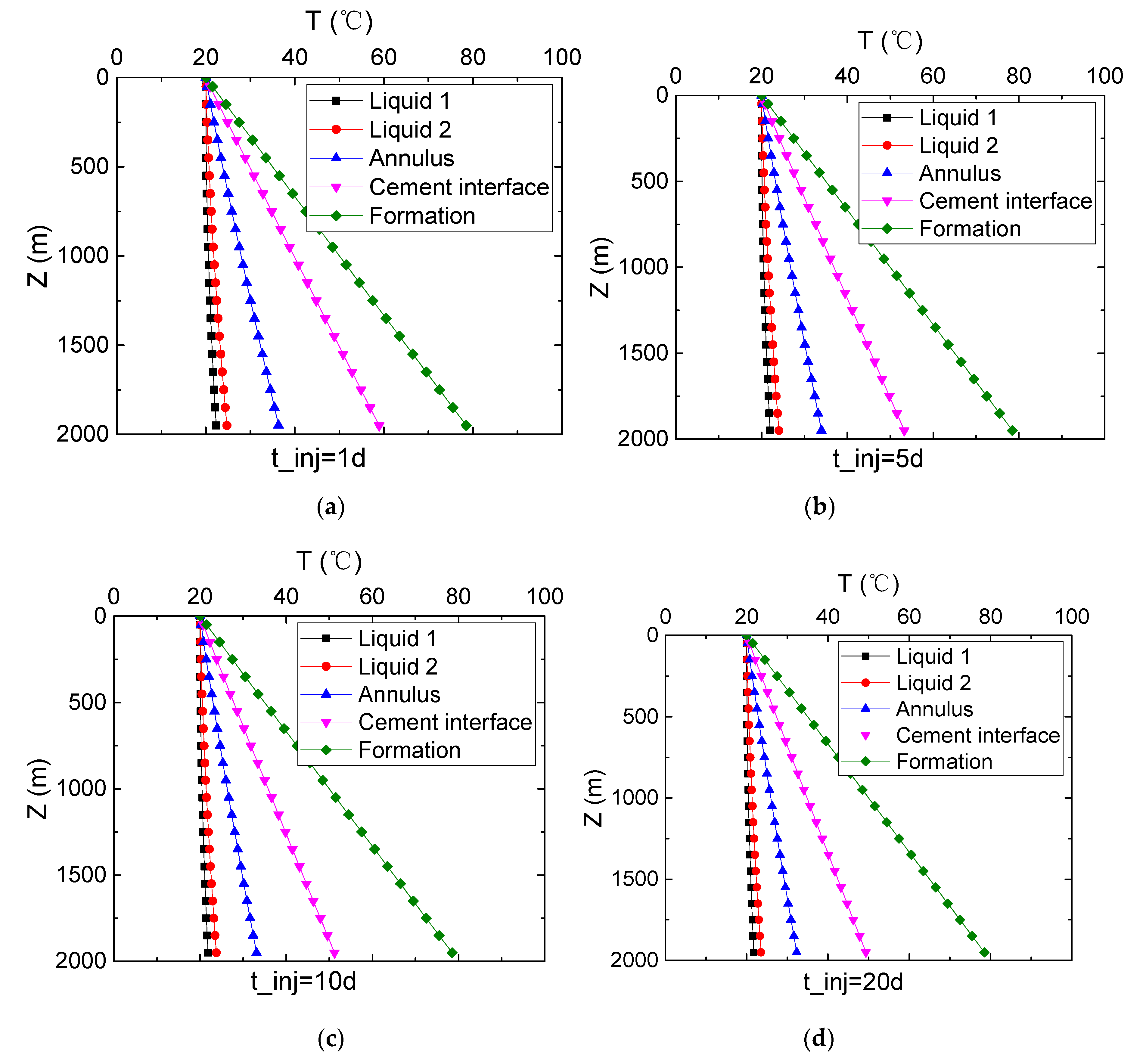
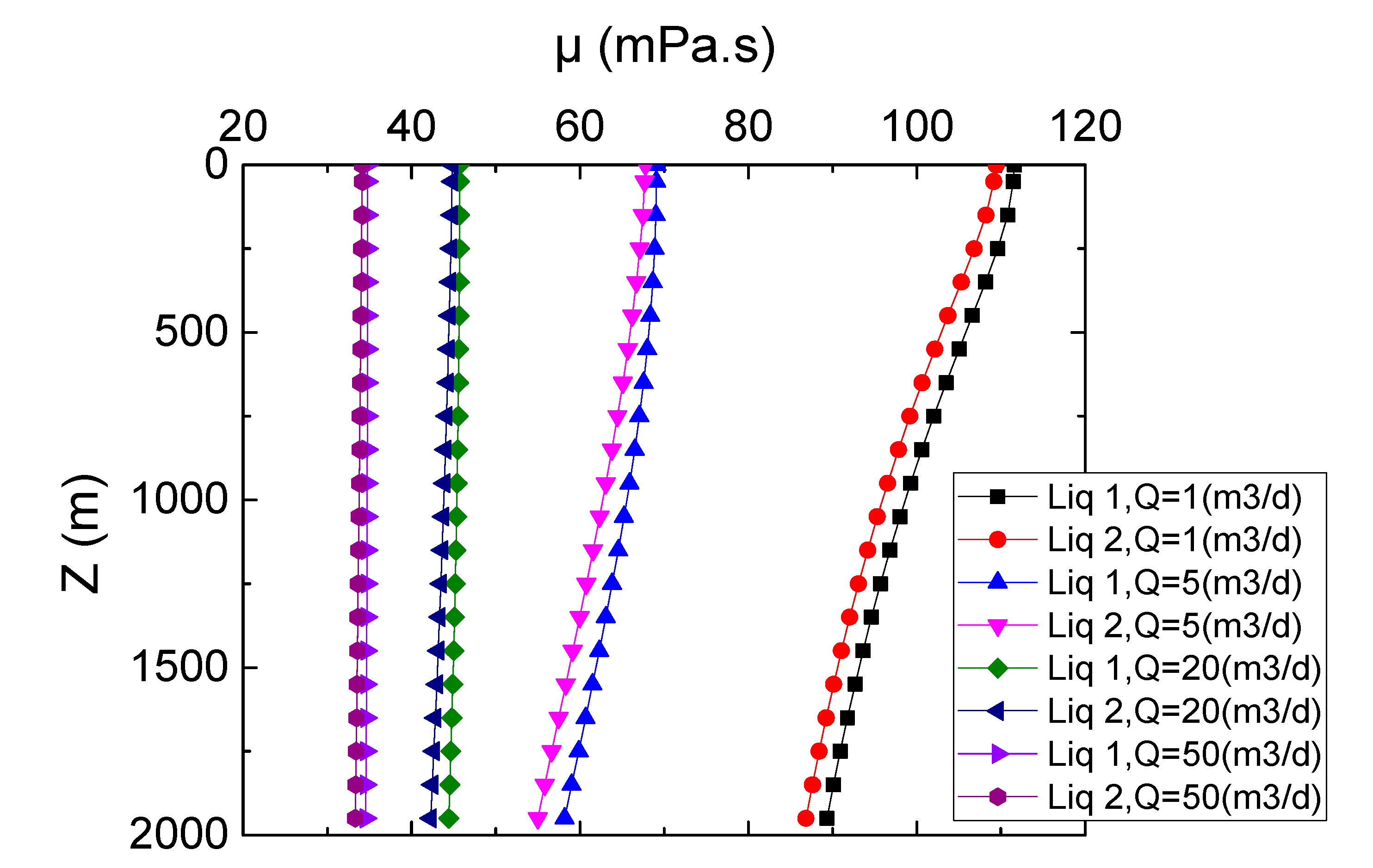
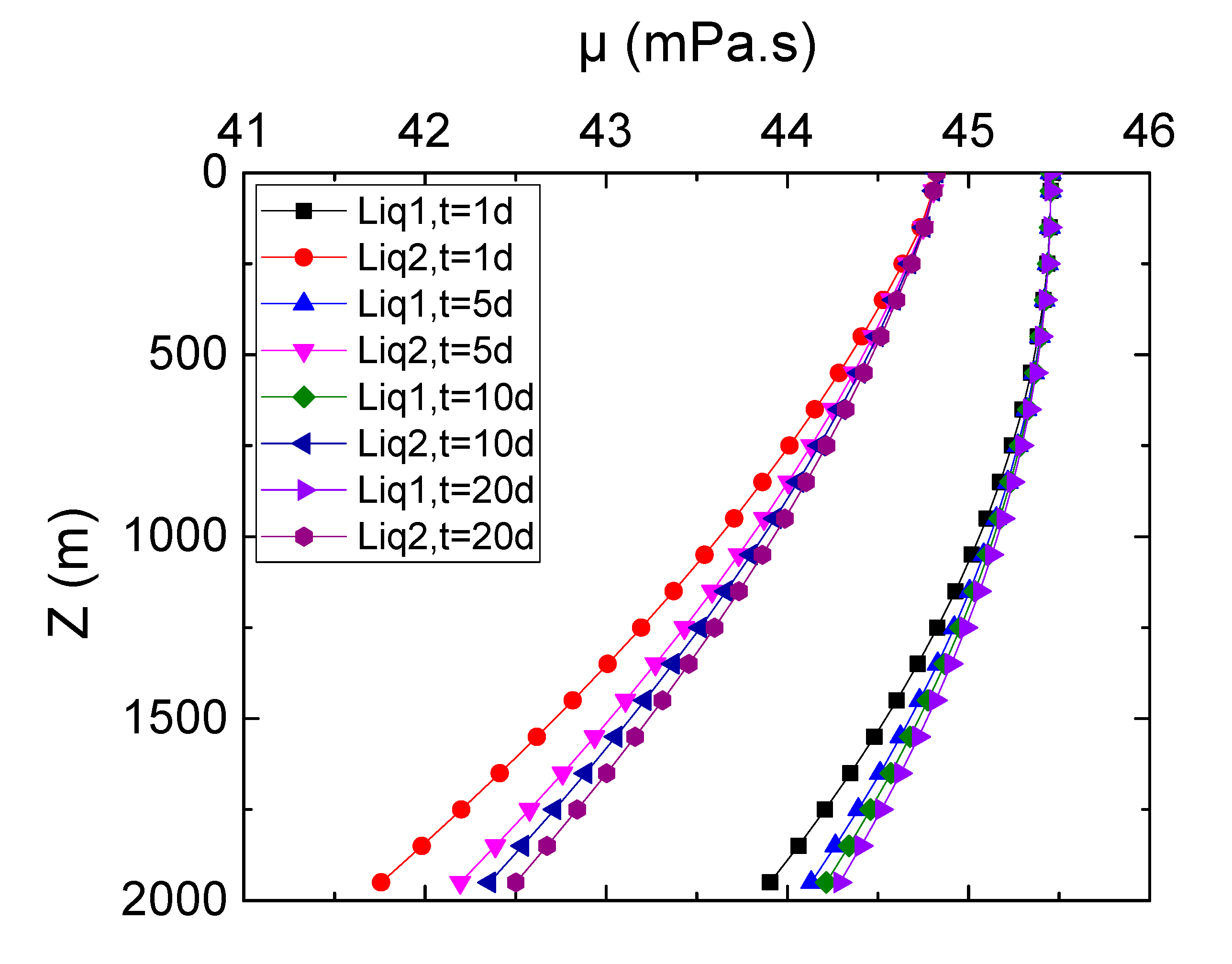
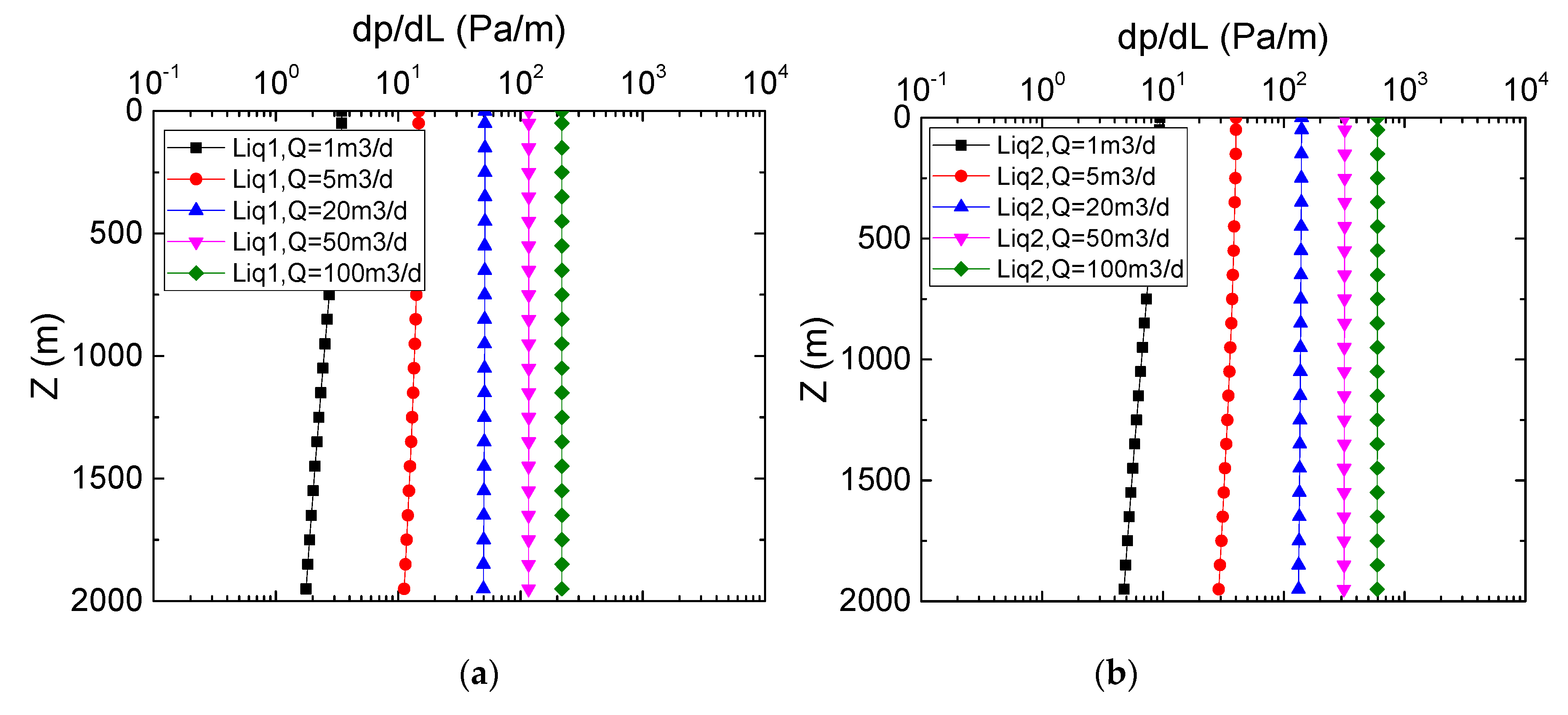

| Parameter Name | Symbol (units) | Magnitude |
|---|---|---|
| Inside radius of inner tubing | (m) | 0.02515 |
| Outside radius of inner tubing | (m) | 0.03015 |
| Inside radius of outer tubing | (m) | 0.0443 |
| Outside radius of outer tubing | (m) | 0.0508 |
| Inside radius of casing | (m) | 0.082 |
| Outside radius of casing | (m) | 0.0889 |
| Radius of cement-formation interface | (m) | 0.10795 |
| Temperature at surface | (°C) | 20 |
| Temperature for injected polymer 1 at surface (in inner tubing) | (°C) | 20 |
| Temperature for injected polymer 2 at surface (in tubing annulus) | (°C) | 20 |
| Geothermal gradient | (°C/m) | 0.03 |
| Thermal conductivity of the formation | (W/(m.K)) | 1.72 |
| Thermal conductivity of the cement | (W/(m.K)) | 0.35 |
| Diffusion coefficient of the formation | (m2/s) | 7.361 × 10−7 |
| Specific heat of polymer 1 | (J/(kg.°C)) | 4200 |
| Specific heat of polymer 2 | (J/(kg.°C)) | 4210 |
| Density of polymer 1 | (kg/m3) | 1010 |
| Density of polymer 2 | (kg/m3) | 1020 |
| Injecting rates for polymer 1 | 20 | |
| Injecting rates for polymer 2 | 20 | |
| Depth unit in Z direction in each iteration | (m) | 100 |
| Depth of well | Z(m) | 1950 |
| The universal gas constant | 8.134 | |
| Activation energy/Arrhenius energy | 10,716.746 | |
| Pre-exponential factor | (mPa·s) | 0.5597 |
© 2020 by the authors. Licensee MDPI, Basel, Switzerland. This article is an open access article distributed under the terms and conditions of the Creative Commons Attribution (CC BY) license (http://creativecommons.org/licenses/by/4.0/).
Share and Cite
Zhang, Y.; Wang, J.; Jia, P.; Liu, X.; Zhang, X.; Liu, C.; Bai, X. Viscosity Loss and Hydraulic Pressure Drop on Multilayer Separate Polymer Injection in Concentric Dual-Tubing. Energies 2020, 13, 1637. https://doi.org/10.3390/en13071637
Zhang Y, Wang J, Jia P, Liu X, Zhang X, Liu C, Bai X. Viscosity Loss and Hydraulic Pressure Drop on Multilayer Separate Polymer Injection in Concentric Dual-Tubing. Energies. 2020; 13(7):1637. https://doi.org/10.3390/en13071637
Chicago/Turabian StyleZhang, Yi, Jiexiang Wang, Peng Jia, Xiao Liu, Xuxu Zhang, Chang Liu, and Xiangwei Bai. 2020. "Viscosity Loss and Hydraulic Pressure Drop on Multilayer Separate Polymer Injection in Concentric Dual-Tubing" Energies 13, no. 7: 1637. https://doi.org/10.3390/en13071637





